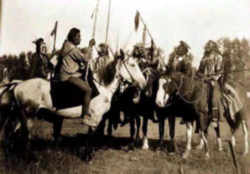


Illinois Early History
First Early Inhabitants of Illinois

Early history examines the archaeological record that tells the story of the first inhabitants of Illinois. Learn about the prehistory and culture of the first early inhabitants, and what lessons it might teach us about the early history of Illinois.
Illinois First Early Inhabitants Timeline
- 10,000 BC- 8000 BC -Paleo Indians roam the area, briefly occupying small camps in coniferous forests and subsisting on large game and wild plants.
- 8000 BC - 500 BC - Archaic period Indians inhabit deciduous forests in small groups, hunt deer and small game, weave baskets, and grind seeds with stones.
- 1000 BC - 900 AD - Woodland Indian era:
- 500 BC - AD 900 - Woodland culture Indians develop maize agriculture, build villages and burial mounds, invent the bow and arrow for hunting, and begin making pottery.
- 90 0- 1500 - Indians of the Mississippian culture improve agricultural methods, build temple mounds and large fortified villages. Most of the settlements are abandoned prior to the historic period.
- 1673 - Jacques Marquette (1637-1675) and Louis Joliet (1645-1700) explore Illinois
- 1680 - Rene Robert Cavelier, Sieur de La Salle (1643-1687) and Henry de Tonty (1650-1704) build Fort Crevecoeur
1680 - The Iroquois entered the region to attack the Illinois Confederacy tribes. Many were killed in the conflict.
Early History of Native Americans in Illinois
The Indigenous People of Illinois
The names of the Illinois tribes included the Illinois tribe (Illini), Iroquois, Chippewa, Ottawa, and Potawatomi, Kickapoo, Kaskaskia, Miami, Shawnee, Sauk and Fox tribes.
Indians hunted in Illinois as far back as 5000 BC and today you can still view the remains of their civilization at places such as Chahokia Mounds - North America's largest and most valuable prehistoric earthwork relic. The earliest inhabitants of Illinois were the prehistoric Mound Builders. Dickson Mounds Indian Museum near Lewiston features special exhibits which chronicle the Indian's valuable place in Illinois history.
These groups of Native Americans left behind more than 10,000 temple and burial mounds throughout the state. Monk's Mound, near present-day Cahokia,
is the largest prehistoric earthen structure in the United States.
Before white men entered the region, it was occupied by a group of six united tribes known as the Illiniwek or Illini, a native word meaning "superior
men."The Illinois confederacy of Algonquian tribes who inhabited parts of Wisconsin, consisted of a group of six united tribes called the Illinois,
Iowa and Missouri, Cahokia, Kaskaskia, Michigamea, Moingwena, Peoria, and Tamaroa. They were all part of the Algonquian family. The word 'Illini' meant
"superior men." The enemies of the Illinois Confederacy were the Illinois were almost constantly harassed by the Sioux, Fox, and other northern tribes.
Some of the other tribes that played a part in the state's early history were the Chippewa, Ottawa, Potawatomi, Winnebago, Kickapoo, and Shawnee. In
1680, the Iroquois entered the region to attack the Illinois tribes. Many were killed in the conflict. By 1800 few Natives remained.





